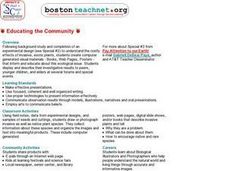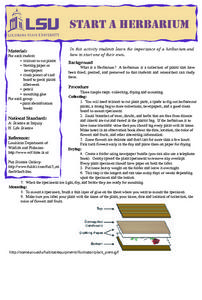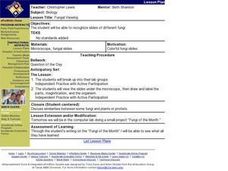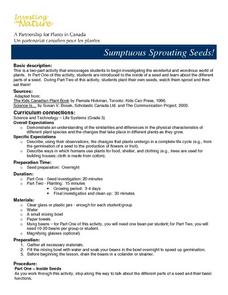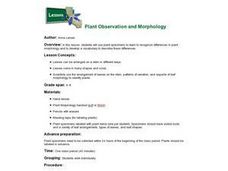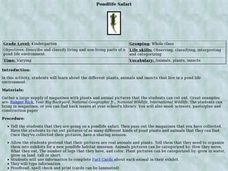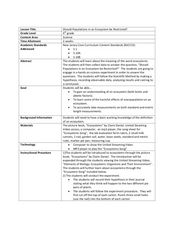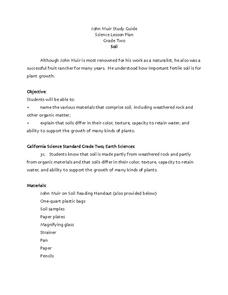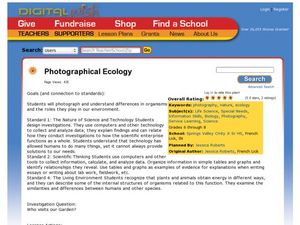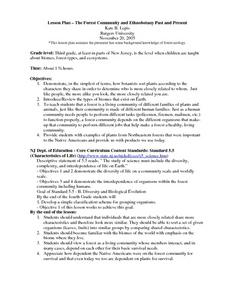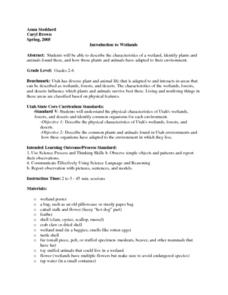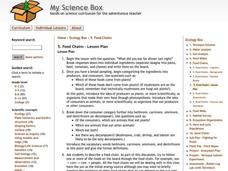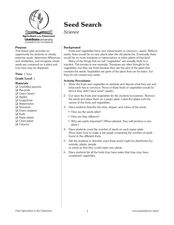Curated OER
Inside A seed
Students examine the inside of a seed to see the beginnings of a plant. They identify the elements that plants need to grow and survive. They grow their seeds in the classroom.
Curated OER
Educating the Community
Students research the effects of invasive and exotic plants. They create posters, webpages and books to educate the community. They present their material in different forums.
Curated OER
Start a Herbarium
Students explore importance of a herbarium and start one of their own.
Curated OER
Plant Collection II
Students mount their first pressed plant specimens and cover some basic plant morphology. They complete a homework assignment to practice their plant collecting and observational skills at home.
Curated OER
Fungal Viewing
Students recognize slides of different fungi. They work in lab groups. Students view slides under the microscope, then draw and label the parts, magnification, and the organism. Students discuss similarities between some fungi and...
Curated OER
Sumptuous Sprouting Seeds!
Third graders investigate the wonderful and wondrous world of plants. They examine the inside of a seed, explore the different parts of a seed, plant their own seeds, watch them sprout and then eat them! They describe, using their...
Curated OER
Growing Money
Fourth graders sell plants. In this business lesson students propagate plants from cuttings. Students create a business to sell the plants they grow.
Curated OER
Plant Observation and Morphology
Learners use plant specimens to explore how to recognize differences in plant morphology and to develop a vocabulary to describe these differences. They brainstorm: What is a plant? What parts do plants have? What is a leaf? Students...
Curated OER
Pond-life Safari
Students determine the living and non-living parts of pond life. In this pond life lesson, students examine the plants, animals, and insects that live in ponds. They look through a variety of print media, cut out pictures, and arrange...
Curated OER
Should Populations in an Ecosystem be Restricted?
Fourth graders experiment to determine how overpopulation effects ecosystems specifically plants. In this ecosystem lesson, 4th graders conduct an ecosystems experiment after listening to Claire Daniel's, Ecosystems. They watch a video,...
Curated OER
Leaf Chromatography
In this leaf chromatography worksheet, learners separate the pigments of a leaf using paper chromatography. They answer 4 questions about their results and draw the colors they observe on their chromatogram from the leaf.
Curated OER
Photosynthesis: Using the Sun to Make Food
In this photosynthesis worksheet, students learn how plants use the sun to convert energy into food. They then answer 10 questions using the information they just read. The answers are on the last page.
Curated OER
Mini-Ponds
For this mini pond worksheet, students create a mini-pond ecosystem with soil, water, and plant life. Students let their ecosystem sit for a day and they observe a sample the next day. Students identify all the pond water microorganisms...
Curated OER
Soil
Second graders name the various materials that comprise soil, including weathered rock and other organic matter. They explain that soils differ in their color, texture, capacity to retain water, and ability to support the growth of many...
Curated OER
Understanding How Potatoes Grow
Second graders make a KWL chart and brainstorm what they need for the project of growing potatoes. They choose one potato and plant it in water or peat moss cups and choose a location in which meets the needs of the plants and make their...
Curated OER
Photographical Ecology
Students study organisms and the roles they play in nature. For this ecology lesson, students photograph several examples of organisms during a nature walk. Students print out their photos and classify the organisms as plants or animals.
Curated OER
Buzzy, Buzzy Bee
Students simulate honeybees pollinating flowers. In this pollination lesson, students role-play the process of pollination over the course of several seasons. Students graph results and share their graphs with the class.
Curated OER
The Forest Community And Ethnobotany Past And Present
Students describe a forest as a living community. They determine members interact, and in many cases, depend on each other for their basic survival needs. They investigate how dependent the Native Americans were on the forest...
Curated OER
Where are the Dinosaurs?
Students understand what it means when an animal is extinct. In this dinosaur instructional activity, students create dinosaur dioramas showing their habitat and what in their environment might make them become extinct. students pay...
Curated OER
A Wild Chain Reaction
Students explore habitats. In this habitat instructional activity, students break into groups and are labeled as a part of a habitat. Students then do an activity with yarn that shows how all of the parts are connected...
Curated OER
Introduction to Wetlands
Students describe the characteristics of a wetland, identify plants and animals found there, and how those plants and animals have adapted to their environment. They visit stations, view a video, and complete a KWL about the wetlands.
Curated OER
Food Chains
Young scholars describe food cahins and the role of organisms. Using a set of organism cards, they color code the organisms on their cards by their role in the food chain. Once a complete chain is identified, they glue it on a sheet of...
Curated OER
Seed Search
First graders examine seeds. For this fruits and vegetables lesson, 1st graders determine what fruits and vegetables have in common. Students cut open fruits and vegetables and examine their seeds. Students describe the sizes, shapes and...
Curated OER
Pollination Parties
Students discuss the pollination of bees and butterflies. In this pollination lesson,students complete a worksheet answering questions about an imaginary bee pollination company. Students understand the relationship...

